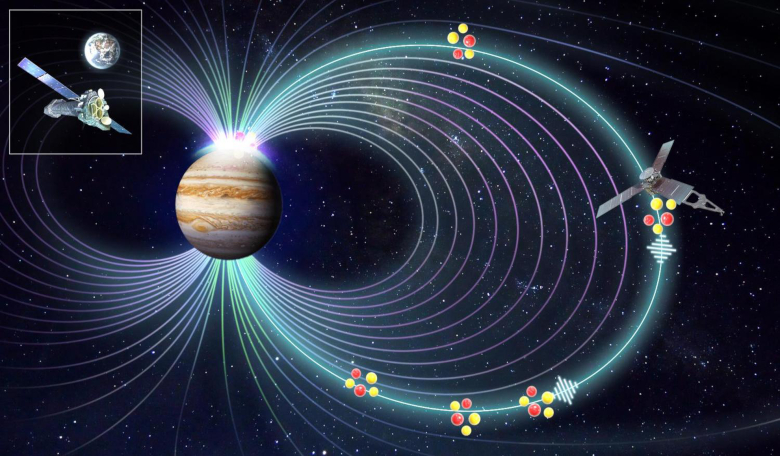For the past 40 years, Jupiter’s atmosphere has been lit up by striking auroras generated by x-ray emission – a phenomena that had been puzzling scientists for decades. Now thanks to a new analysis of data from ESA’s XMM-Newton telescope and NASA’s Juno spacecraft, a team of researchers have found that ions ‘surfing’ electromagnetic waves in Jupiter’s magnetic field are the cause of these stunning light displays.
Of all of the planets in the Solar System, Jupiter has by far the most energetic and brightest auroras.
At 100 times more energetic than auroras found on Earth and with up to 10 times higher surface brightness, it is thought that the gas giant’s huge and powerful magnetosphere – a product of the strong internal magnetic field of Jupiter – is behind the processes driving those emissions.
Strangely though, although both Jupiter and Saturn have magnetospheres (the region around a planet dominated by the planet's magnetic field), Jupiter produces bright and energetic X-ray auroras, but Saturn doesn’t.
Stranger still, a few years ago scientists discovered that unlike Earth’s polar lights, the intense auroras seen at Jupiter’s poles didn’t coordinate, meaning that they unexpectedly behaved independently of one another.
They also look very different too. For instance Jupiter’s polar aurora is often grouped into at least three structures, including a “swirl region” in the center, an “active region” of flares, bright spots, and arc-like structures on the duskside and a “dark region” located on the dawnside.
But why? Magnetic field lines on Earth resemble those produced by a bar magnet. If you placed a magnet at the centre of earth and oriented it along a south-north direction, some field lines would loop from one pole to the other, but the vast majority of field lines are open and extend thousands of kilometres into space where they join up with the magnetic field in the solar wind; the stream of electrically charged particles that emanate from the Sun.
As such, on Earth, auroras are visible only in a belt surrounding the magnetic poles, between 65 and 80 degrees latitude. Beyond this latitude, the auroral emission disappears because the magnetic field lines become open.
On Jupiter however, auroras exist poleward of the main auroral belt and those in the south are known to pulsate every 11 minutes; features that are typical of a ‘closed’ magnetic field, even though all planets with magnetic fields have both open and closed field components.
Astronomers were sure that the X-ray ‘colours’ of these auroras are triggered by electrically charged particles called ions crashing into Jupiter’s atmosphere, but had no idea how the ions were able to get to the atmosphere in the first place.
By matching computer simulations with observational data taken by XMM-Newton and Juno, a team led by Zhonghua Yao, at the Chinese Academy of Sciences, Beijing say they have the answer.
According to Yao and colleagues, magnetic field lines that are generated inside Jupiter and then stretch out millions of kilometres into space before turning back, are being struck directly by the ions of the solar wind.
But, instead of being repelled and sent back out into space, the ions are being trapped in Jupiter’s magnetic field.
When this happens the magnetic field gets compressed, which in turn heats up the ions.
This then triggers a phenomenon called electromagnetic ion cyclotron (EMIC) waves and the ions then ‘surf’ the EMIC eventually slamming into the planet’s atmosphere and triggering the X-ray aurora.
“What we see in the Juno data is this beautiful chain of events. We see the compression happen, we see the EMIC wave triggered, we see the ions, and then we see a pulse of ions traveling along the field line. And then a few minutes later, XMM sees a burst of X-rays,” says William Dunn, Mullard Space Science Laboratory, University College London, who co-led the research.
Now that the process responsible for Jupiter’s X-ray auroras has been identified for the first time, it could be used to study the role of magnetic fields on other planets, and how they interact with the interplanetary medium around them say the team.
“This is a fundamental process that’s applicable to Saturn, Uranus, Neptune and probably exoplanets as well,” says Yao.
The result also highlights how similar the ion auroras that happen here on Earth are with those on Jupiter despite their visual differences, Yao and colleagues say.
In the case of Earth, the ion responsible for the auroras is a proton, which comes from a hydrogen atom, and the process is not energetic enough to create X-rays. Jupiter’s X-ray aurora on the other hand is fundamentally an ion aurora, although at much higher energy than the proton aurora on Earth, so the basic process is that same.
“It could be that EMIC waves play an important role in transferring energy from one place to another across the cosmos,” says William.
More will be learnt about the auroras and other aspects of Jupiter when ESA’s JUpiter ICy moons Explorer (JUICE) arrives at the gas giant by 2029. When settled in its orbit, JUICE will study the planet’s atmosphere, magnetosphere, and the effect that Jupiter’s four largest moons have on the auroras.











